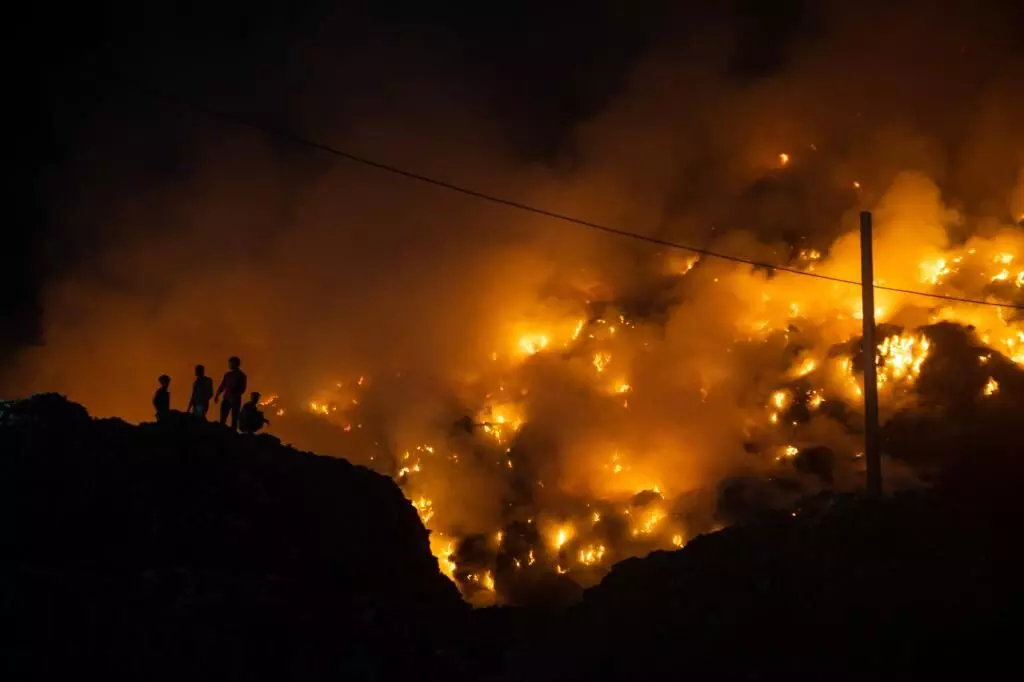Up in smoke
Bandhwari dumpsite fire underscores an urgent need to overhaul waste management practices in Gurugram, so that future fires can be prevented

The Bandhwari dumpsite, located in Gurugram, India, has once again found itself engulfed in flames, marking the fourth fire incident within a single month, this being the major one. Despite concerted efforts to contain the fire, its resurgence serves as a stark reminder of the persistent challenges inherent in landfill management and the urgent need for holistic solutions to address them effectively.
This was the second landfill blaze in the national capital region this week.
Since its inception in 2010, the Bandhwari dumpsite has become a major waste repository in the region, receiving over 1,600 tonnes per day (TPD) of mixed waste from Gurugram (1,000 TPD) and Faridabad (600 TPD). Unfortunately, only a small fraction — about 200-250 TPD in Gurugram and 400 TPD in Faridabad, of the 1,200 TPD and 1,000 TPD generated by the two cities — is processed.
The remainder is simply dumped on the site without proper oversight. The Municipal Corporation of Gurugram has a biomining capacity of 16,000 tonnes, but 1,600 tonnes of fresh waste is dumped into the dumpsite each day. This is primarily due to a lack of source segregation and a 30-40 per cent door-to-door collection rate.
For the past 6-7 years, the city has faced significant waste management challenges due to a tripartite agreement in between a concessionaire and the government of Haryana since 2017.
The concessionaire was tasked with providing comprehensive end-to-end services, including source segregation, door-to-door collection, processing, dumpsite remediation and establishing a waste-to-Energy plant within five years of their twenty-two-year agreement.
However, the concessionaire failed to meet these obligations, resulting in the shutdown of waste management services in the city. Source segregation and door-to-door collection rates plummeted and the installation of necessary waste processing plants was not achieved, leading to an inability to divert fresh mixed waste from the dumpsite.
Despite the use of biomining processes to extract valuable materials from waste, a significant amount of residual waste remains on the site, exacerbating the looming threat of conflagration.
While biomining efforts have produced commendable results, with approximately 21,50,000 tonnes of waste processed in the last year and three months, formidable challenges remain, as evidenced by the recent spate of fires.
The latest fire incident at the Bandhwari dumpsite, which broke out around 8-8.30 p.m. on April 22, 2024, was exacerbated by the current atmospheric conditions. Although initial containment efforts were successful in extinguishing the flames around 1 am, the fire rekindled with the arrival of dawn, emphasising the severity of the situation.
Fortunately, no casualties were reported, but the recurrence of such incidents highlights the critical need for a thorough investigation of the underlying technical dynamics that cause landfill fires.
The scientific basis for dumpsite fires is complex and multifaceted, resulting from the convergence of physical, chemical and human factors. A variety of processes at dumpsites like Bandhwari contribute to the generation of heat, which is a precursor to fires. Among these, the decomposition of biodegradable waste plays a pivotal role, as the breakdown of organic matter releases heat, consequently raising temperatures within the dumpsite.
Furthermore, the anaerobic decomposition of biodegradable waste results in the emission of methane gas, a highly combustible substance. Studies have indicated that methane concentrations within dumpsites (3-15 per cent) can far exceed those found in the natural atmosphere (0.00017 per cent), posing a significant ignition risk.
Compounding this risk are the presence of ignitable materials, commonly known as “hot loads”, comprising a variety of combustible materials such as brush, leaves, fuel, tires, or reactive chemicals, which can spontaneously ignite, creating a volatile environment conducive to fire outbreaks.
External sources such as equipment, smoking and waste recyclers further contribute to the ignition potential, complicating fire containment efforts.
Sub-surface fires pose an even more formidable challenge at dumpsites, arising from the infiltration of air into the waste mass, thereby providing oxygen to sustain combustion. The waste materials, combined with methane generated within the landfill, serve as fuel for these fires, which remain concealed beneath the surface, evading detection and extinguishment.
Sub-surface fires not only endanger the lives of workers and firefighters but also pose environmental risks, leading to slope instability and the release of harmful emissions.
To reduce the risk of future fires at Bandhwari and other dumpsites, Gurugram’s waste management practices must be completely overhauled. Source segregation, which involves diverting waste to different facilities to reduce the risk of combustion, is central to this effort.
A strong communication strategy must be developed to foster behavioural change among residents and encourage them to embrace segregation practices.
Furthermore, biodegradable waste should be systematically diverted away from dump sites, with a preference for decentralised treatment methods like composting or biomethanation.
The conversion of organic waste into bio-compressed natural gas not only reduces pollution but also provides a viable revenue stream. Embracing dry waste recycling initiatives and transitioning towards a zero-landfill model are pivotal steps towards sustainable waste management practices.
Interim measures such as installing gas vents and compaction of waste, combined with daily soil cover, are critical for controlling methane gas accumulation and preventing fires.
Regular monitoring and training programmes for workers and officials are required to identify and remove potential hot loads, while strict compliance with regulations, including smoking bans in dumpsite areas, is critical to reducing fire hazards and protecting public health and safety. DTE
Views expressed are personal




